#UnheardVoices
Explore tagged Tumblr posts
Text
When a Man Stops Trying
There’s a moment a quiet, almost imperceptible shift when a man stops trying. Not because he’s lazy, not because he’s heartless, but because he’s spent. Every explanation, every argument, every ounce of effort has drained him dry, and he’s finally realised the hardest truth of all: it doesn’t matter anymore. Nothing will change.
At first, he fights. He raises his voice, not in anger but in desperation, trying to be heard. He tries to fix things, tries to explain, tries to hold on. He believes in love, believes in effort, believes that if he just says the right words, does the right things, things will get better. He stays up at night replaying conversations, thinking of what else he could do, how else he could reach her. But there comes a day when the fire dims, when the words don’t come, when the weight of trying is heavier than the weight of letting go.
Men don’t always leave with slammed doors and packed bags. Sometimes, they leave while still sitting beside you. Their presence becomes hollow, their words mechanical, their eyes distant. It’s not healing. It’s not acceptance. It’s surrender. It’s the moment a man realises that no matter how much he gives, he will never be enough for someone who has already let go of him in their heart.
And so, he withdraws. Not to punish, not to manipulate, but to protect what’s left of himself. The calls become less frequent. The texts go unanswered. The space between him and the world grows wider. He stops explaining, stops reacting, stops expecting. Not because he doesn’t care anymore, but because caring has become too damn painful.
This isn’t about weakness. It’s about survival. A man will fight for love, but he will not fight for nothing. The moment he realizes his effort is a scream into the void, he will go silent. And when a man goes silent, when he chooses peace over chaos, distance over devotion, solitude over suffering that’s when he’s already gone.
No anger. No resentment. Just the quiet acceptance that some things aren’t meant to be, no matter how much you want them to be.
#MenAndEmotions#WhenAManStopsTrying#SilentGoodbye#EmotionalExhaustion#FightingForLove#LettingGo#UnheardVoices#MensMentalHealth#RelationshipStruggles#EmotionalWithdrawal#KnowingWhenToWalkAway#PeaceOverPain#SilentResignation#TheWeightOfTrying#MovingOn#HeartbreakAndHealing#SelfPreservation#ChoosingPeace#UnspokenGoodbyes#EmotionalSurvival#deep thinking#deep thoughts#today on tumblr#new blog
0 notes
Text
Lowkey Rebel: How Vietnamese Women Used Codes to Talk About Sexual Violence
Ever thought about how messed up it is that some people can’t even talk about their trauma without it being brushed aside? Picture this: no social media, no memes, no cryptic tweets with a Taylor Swift lyric to express your pain. All you have is your voice. These women turned lullabies, folk songs, and even casual conversation into codes - like an OG version of sub tweeting.
Now, imagine being a Vietnamese woman during the war. The stuff they went through - sexual violence, loss, and unspeakable pain - was happening right under the radar. But here’s the crazy part: these women didn’t have the luxury of just speaking out. Society wasn’t having it. So, what did they do? They got clever. They turned everyday language into a secret code, using lullabies, folk songs, and even casual conversation to spill the truth about their suffering. Sounds wild, they couldn’t just shout “I’m hurting” because the world wasn’t listening, so they embedded their pain in hidden messages. Like, imagine writing a post but using emojis that only certain people would understand - same vibe, just way more intense. These women became masters of coded language, slipping their stories of trauma into songs and conversations that seemed innocent to the untrained ear. It wasn’t just survival; it was resistance. They were screaming for help without ever actually screaming. So, how do you think you’d survive if the only way to speak up was through hidden signals? Would you have the courage to decode and listen? Because these women, despite everything, found a way to make their voices heard - loud and clear, even if the world wasn’t ready to listen.

Let’s talk about “Con Cò Bé Bé” (Little Stork). At first glance, it’s just a lullaby about a stork and a baby, right? But, like a lot of things in history, what’s seen isn’t always what’s heard. Underneath this seemingly sweet, soothing melody lies a whole world of unspoken trauma. The stork, in this case, isn’t just a bird - it’s a metaphor for the things that were taken away. The woman singing this lullaby isn’t just calming her child; she’s whispering the agony of losing loved ones, of war, of violence, and the heartbreak of a peace that never arrived. If you didn’t know the context, it might sound like a pretty innocent song, right? But for those who had been through the pain, it was an unspoken truth. That’s the power of coded language - when you can’t outright say what’s really going on, you bury it in things that seem innocent. And this wasn’t the only lullaby like this.
youtube
Take “Bèo Dạt Mây Trôi” (Floating Water Lily), for instance. On the surface, it’s another lullaby, another cute story. But dig deeper, and you’ll find it's actually a woman’s tale of being lost, drifting away from everything she knows - something many women during the war could relate to as they dealt with their own displacement and loss. These lullabies were like secret passwords passed down, like messages from one generation to the next. Imagine that: a woman singing to her child, passing down her pain and resilience in the form of a song, knowing that the child would grow up understanding that this wasn’t just a bedtime tune - it was a survival song, a quiet scream for the world to hear.
youtube
Scholars like Nguyen Thi Minh Thien (2020) and Le Thi Hoa (2021) have broken down the hidden genius of these coded lullabies, calling them "resilient acts of rebellion" that allowed women to survive in silence. Thien argues that these songs were a form of resistance - not in the typical protest sense, but as a quiet, everyday rebellion against the oppression and violence of war. This wasn’t about marching in the streets or shouting in the face of the government, it was about survival in its most subtle form. Think about it - what do we do today when we can’t directly speak out? We tweet, we post memes, we make art. These women didn’t have that privilege. They sang. And through these melodies, they embedded coded messages of grief, trauma, and resistance, all while hiding it in plain sight. It’s almost like an ancient version of what we do now with subtle activism - like using “cancel culture” to critique power dynamics or embedding resistance in pop culture references. Hoa, on the other hand, takes this a step further, claiming that these lullabies were the cornerstone of cultural survival. They weren’t just preserving memories - they were actively keeping their identities alive in the face of genocide and war. So, when you think about it, these songs weren’t just lullabies - they were an entire survival manual for women navigating the worst. They turned their pain into an art form, one that’s survived across generations. And honestly, if we’re ever in a similar situation today, wouldn’t we do the same?
Just think - how many times have you shared an inside joke or meme that only your closest friends get? This isn’t that much different. What’s the true power of a “coded language”? It’s that it allows us to keep our voice, our stories, and our history alive - without ever needing to shout. And now, here’s the million-dollar question: if the only way you could tell your story was through hidden messages, would you? Could you? And more importantly, would anyone bother to decode it? These women proved that even in silence, their voices were louder than the world ever expected. The least we can do now is listen.
CITATION
Nguyen Thi Minh Thien. 2020. The Role of Folk Songs in Preserving History.
Le Thi Hoa. 2021. Oral Traditions and Memory.
#CodedLanguage#VietnameseWomen#BreakingSilence#SexualViolence#Resilience#UnheardVoices#vietnam war#Youtube
0 notes
Text
Left Unread
For every Helmet for my Pillow–
How many memoirs go unpublished?
Their poems left unrecited.
The words long written down
never to be bound by our cultural consciousness;
left to rot– in their pockets,
slowly washed away with crimson blood
or blown to shreds from falling rockets.
Their silent echoes hushed by the battlefield;
the shadows of their memories
never illuminated nor revealed.
The writings of the dead;
their remains forever left unread.
#WarPoem#Memoir#UnheardVoices#UntoldStories#BattlefieldPoetry#WarMemories#ForgottenWords#PoetryOfWar#UnpublishedWorks#SilentEchoes#WarAndLiterature#UnrecitedPoems#CulturalConsciousness#PoetryOfTheDead#LeftUnread#WritingInBlood#BattlefieldSilence#PoeticReflections#WarLegacy#UnseenShadows#UnrevealedMemories#FallenSoldiers#WarStories#HauntingWords#PoetryOfRemembrance#LiteraryGrief#EchoesOfWar#WarAndPoetry#SilentWritings#PoetryOfLoss
1 note
·
View note
Text

Scepter of Leptys trailer was so good you know I'm making a verse for it when it releases !
#🌧️ 𝘏𝘐𝘋𝘐𝘕𝘎 𝘍𝘙𝘖𝘔 𝘋𝘈𝘕𝘎𝘌𝘙 / ooc .#i'll credit Unheardvoices for sure also also Ly on my multi will get a verse from the series too it looks so good i'm so excited#i dont care how long i gotta wait for it
2 notes
·
View notes
Text
Surrounded Silence
Their laughter doesn’t reach me. Their eyes slide off like water. I’m here— but not invited. I speak in decibels no one hears. I sit beside them, but I’m orbiting the room, unseen and slowly fading.
#crowdedbutalone#unheardvoice#fadedpresence#nobodyseesme#socialghost#trappedincompany#lonelyinpublic#orbitingreality#emotionallyinvisible#silentoutsider#infj thoughts#mental health#poetry#poet blog
0 notes
Text
Excuse Me!—A Story of Unspoken Words
Sometimes, the most powerful stories are the ones left untold. #UnspokenWords #SilentStories #ListeningHeart #ExcuseMe #UntoldTales #PowerOfSilence #EmotionalJourney #UnheardVoices #ReflectiveMoments #UntoldEmotions
After a long time, I finally got a chance to sit down and have a real conversation with you. It felt like a moment I had been waiting for. It was an opportunity to share and connect. We could exchange our thoughts and feelings without the rush of daily life pulling us away. As soon as we started talking, you dove straight into your thoughts, unraveling them one after another. First, it was your…
0 notes
Text
Meet Shivani Pandey, she is a highly creative and driven professional, widely recognized for her exceptional skills in filmmaking, photography, and writing. For more information visit www.samayyaan.com #ShivaniPandey #Filmmaker #Photographer #Writer #ArtisticVision #KathaUtsav #AzadiKaAmritMahotsav #MinistryOfCulture #SamayYaan #Poet #HindiLiterature #LiteraryFestival #CelebratingArts #LegendaryWriters #Kahaniyan #Aarambh #SakshatSamaj #ArtsandCulture #UnheardVoices
Edited · 9m
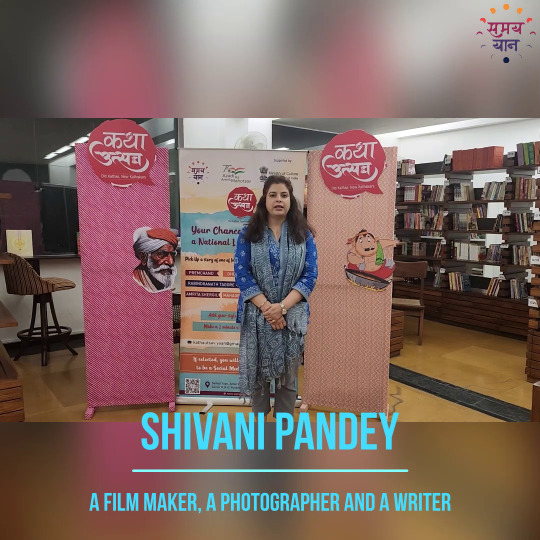
0 notes
Text
@unheardvoices ♡’d for a one-liner for BRITT !

❛ that jacket is absolutely KILLER. where did you get it ? ❜
#unheardvoices#how 2 make friends: compliments#lots and lots of compliments#really fashion is one of the first things lydia notices about people#and she knows style when she sees it#<333
5 notes
·
View notes
Video
instagram
This is Muhlaysia Booker. The news reports Muhlaysia was killed over the weekend in Dallas. Muhlaysia is the trans-woman whose attack went viral a few weeks ago showing her brutually being kicked and beaten by a man. No matter your beliefs, no person should have to endure this! We're uplifting her family, friends, and the lgbtq 🏳️🌈 community up in prayer! R.I.P. Muhlyasia! ------------------------------------------------------ #MuhlaysiaBooker #blacktranswomen #dallas #Lgbtq #unheardvoicesmag #unheardvoices #stopthebullying #stoptheviolence https://www.instagram.com/p/Bxvh1RIluYQ/?igshid=bqkqz89q0znj
#muhlaysiabooker#blacktranswomen#dallas#lgbtq#unheardvoicesmag#unheardvoices#stopthebullying#stoptheviolence
1 note
·
View note
Text
AIGA - Eye On Design Magazine

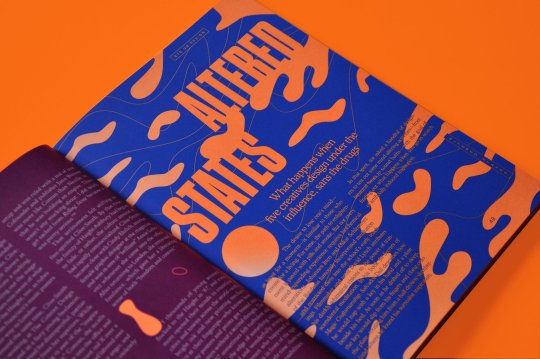
For this project I decided to go online and purchase a magazine that Ive never heard of before, this was so I could look and try and figure a new route of research rather than going to the same areas on the internet like I tend to normally do when beginning my initial research. In this edition it had a whole section on female psychedelic artists. Using their names I then went online which eventually lead me to April greiman. This is definitely an interesting and more source full way to beginning a new research topic.
1 note
·
View note
Photo

This is why I decided to dedicate my life towards organizing. In communities of color, we are oppressed for many different reasons but it shouldn't mean we should oppress others or within ourselves. Toxic masculinity is something so fixed inside our communities that we think it's something that is a part of our cultures when really it never was... #toxicmasculinity #rapeculture #rapecultureiswhen #feminism #feminist #feminista #ineedfeminismbecause #liberatethyneighbor #newtypeofrevolution #newkindofrevolution #communitiesofcolor #socialjustice #organizing #activism #intersectionalfeminism #intersectionality #intersectionalitymatters #domesticviolence #unheardvoices https://www.instagram.com/p/Boepkxen3TH/?utm_source=ig_tumblr_share&igshid=dgm3k1uj2oij
#toxicmasculinity#rapeculture#rapecultureiswhen#feminism#feminist#feminista#ineedfeminismbecause#liberatethyneighbor#newtypeofrevolution#newkindofrevolution#communitiesofcolor#socialjustice#organizing#activism#intersectionalfeminism#intersectionality#intersectionalitymatters#domesticviolence#unheardvoices
1 note
·
View note
Photo

ERON
The second brief of the year is called Unheard Voices and is focused on finding an artist or creatives in design, literature or film that we think should be more famous or known by everyone else giving the reason why and to create a response for it using any medium we want.
I was actually excited about this brief and thought it was a very good idea and it would have been fun and interesting to represent another artist but probably using a creative medium different from the one of the person chosen.
It was quiet easy for me to come up with an artist because I always been very fascinated about a spray painter from my same hometown, Rimini.
His artistic name is ERON but his real name is Davide Salvadei. Born in 1973, he started his practice when he was around fifteen. He attended Artistic High-Shool in Rimini followed by studies in arts at University. Despite the academic training at the Urbino School of Art, the frst teaching in the field of creative and artistic expression comes from the street. After several years of illegal activity and dozens of wagons painted with a recognizable style and signifcant local and national infuence, Eron blends harmoniously with his academy and street experiences. It takes on a highly evocative painting that utilizes the virtuosic and hyper-sensitive use of the spray, which maximizes the peculiarity of returning an incorporeal and smoky visual efect, resulting from the ability to control the force and consistency of the jet. This results in a delicate hue.
The work I personally like the most is titled “Mindscape”, it consists of landscapes that describe our land of origin, where the sea, clouds, urban scenery, silent and sandy sea dominate. The aura is dreamy, enters the subconscious, realizing a pictorial space and time made of rarefed dust, which only by looking from afar allows to have a complete picture of expression, with sensations of melancholy. He often works on feelings he has experienced and the atmospheres he has been impressed with in various situations that he personally experienced.
Most of his works indeed relate to me because of both subjects and location. I recognise the places from my hometown in his paintings and they bring up memories of my past or every day aspects of time spent at home. Some of them are painted on houses that I see everyday walking in the street. I previously said that “Mindscapes” is my favourite work because it relates to places I’ve been to many and many times, specially by the sea where every Sunday, when I was younger, I used to walk with my grandmother. I reconnect all of these memories to a dreamy atmosphere. I love the feelings you can experience looking at his paintings and how he focuses on common aspects and everyday life moments to make them accessible to everyone and not just to me only because we both come from the same town. These aspects and the incredible realism of his paintings are what mostly inspired me and lead me to create my creative response.
It is indeed on memories and feelings that I tried to base my work trying to express them in a relistic way through photography but experimenting with lights,diferent materials, textures and techniques. The reason why I chose photography as a medium is because, he often uses photos as a starting point to achieve the best results in his paintings. I liked the idea to have the same starting point but trying to consider it in a non-static way, creating something diferent, as he also does, but developing my own personal response.
He is a really talented artist who has been able to transform spray painting to an art form through expression from originally it being considered illegal. He is the frst artist that was commissioned to paint the sealing of a Church, in a town really close to Rimini, using an approach that was considered illegal, which I fnd really strong in his contraddiction. His approach is also fascinating, when he paints he “listens” to the noise of the spray which he recognises from the diferent pressures and will create the specifc efect he wants in relation to this. I also fnd it intresting how he has always incorporated the surroundings into his paintings. The train part of the work is given by the surrounding context in the sense that there is a contrasting harmony between the colorful painting and the gray and mechanical environment of the railways that complete the ‘Opera’.
2 notes
·
View notes
Photo

#sadshayri #shayriquotes #shayri_addicted #shayris #struggle #stresslife #recession #purse #desire #unheard #unheardvoices (at Surat, Gujarat) https://www.instagram.com/p/BlFSF0rH0U_/?igshid=13wmrvphlb2i0
#sadshayri#shayriquotes#shayri_addicted#shayris#struggle#stresslife#recession#purse#desire#unheard#unheardvoices
0 notes
Text
Not Technically Competent Enough/Design Update

My initial design for the clock was based on the way spatial neglect patients draw it when they are asked to represent the time. They squeeze all the numbers on one size due to their lack of attention to the stroke-affected side, unknowingly leaving a big white space. In wanting to design a clock that would enable the patients to read the time easily, I set out to create a working physical copy of their representation of the clock. To do this one thing was necessary: to slow down the clock mechanism to exactly half the speed. Through my research, I found out this could be done in one of two ways: either by altering the mechanical gear chain inside the motor, or by rewiring the electronic component of the quartz mechanism, neither of which turned out to be particularly easy for a beginner like myself. Nevertheless, I learned the basics of gear engineering and figured out the math, also with the help of an Masters Mechanical Engineer from Imperial University.
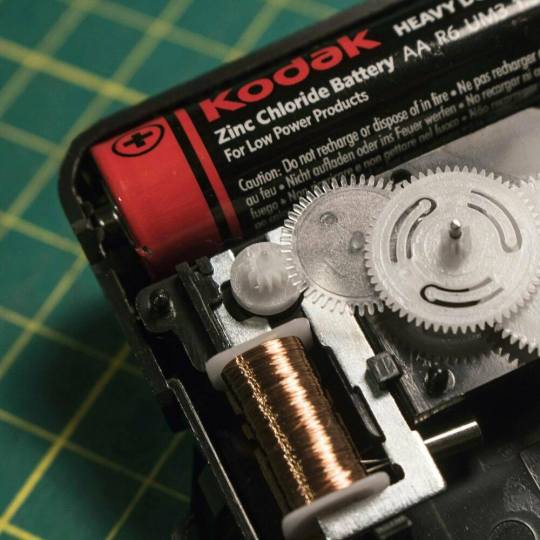

The solution to the problem turned out to be theoretically quite simple, but practically almost impossible. I just needed to find a single gear, double to diameter of the driving gear of the motor, which had the same size but double the amount of teeth. By inserting that into the gear chain, it would force the whole thing to slow down by half. After having bought and tested 58 different gears off the internet, the possibility of finding a gear that was as small and as specific as I needed faded away quickly. I considered 3d printing, but that wouldn’t have worked because of the insanely minute scale of what I needed to produce. On top of that, I would’ve had to produce another contained for the gear mechanism that accommodated for the insertion of the new piece.
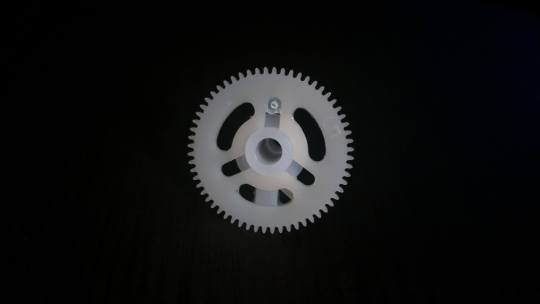
So I moved onto my second option, which was electronic. Having been learning about Arduino’s in the last few weeks I was excited to test something out but, still in conversation with my engineering expert, I soon realised that, even if the software and code was correct, it would have been difficult to produce the clock as a standalone object, disconnected from the computed software. This would’ve have prevented it from being hung, which ultimately defeats the purpose of having a clock and of the project altogether. So that didn’t work either.
These problems had arisen from the initial design choices I’d made almost instinctively, so I decided to go back and revise. Eventually I came up with some new ideas, one of which seemed more promising.
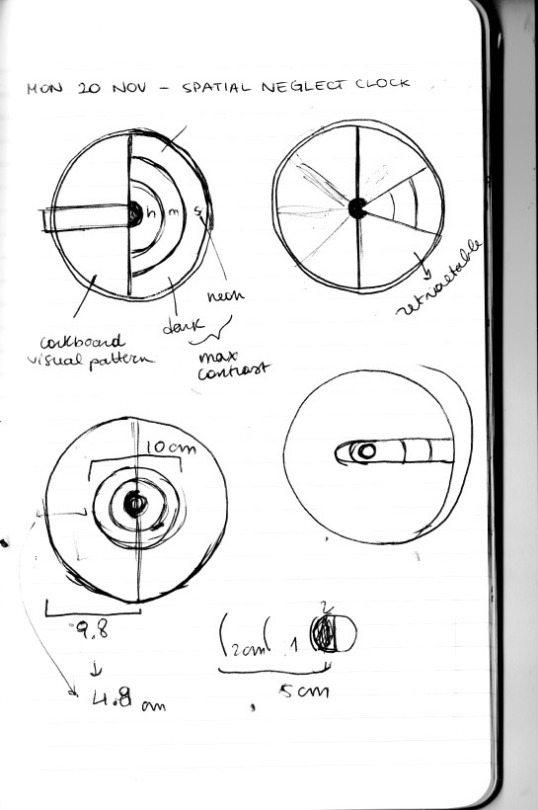
I decided to think of the clock in terms of its most basic components, re-thinking how it could work. Instead of having the hands move, could I have the numbers move instead? In this way, the hand could remain fixed on one side, the numbers moving around it, making it always visible for stroke victims with spatial neglect.

This direction would enable me to still use the quartz mechanism I had without having to spend all my remaining time learning a new skill (while this would have been great and surely useful in the future, it really worried me in terms of achieving an appropriately finished outcome). I swapped each of the hands on the rotating central rod of the mechanism with three separate discs. These would rotate at the same speed of the hands, but they would indicated the numbers instead.

I first cut a prototype out of mount board, just to figure out how everything would work together and how I should lay out the numbers. I quickly used some Letraset transfers I had lying around.
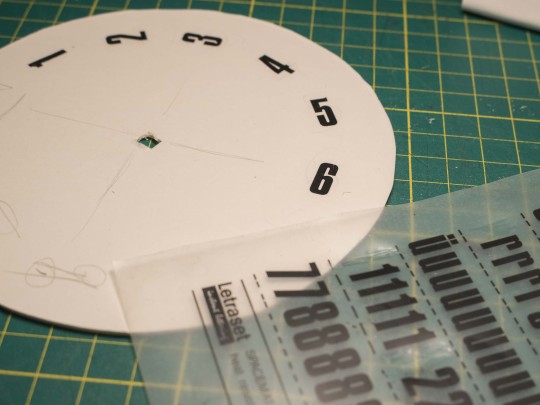

Everything seemed to be working okay, except, since it wasn’t cut too precisely, the discs were touching in parts creating friction and altering the speed. I thought that maybe my material choice was unsuitable, so the next day I tried cutting up some plastic to see if that was more rigid.
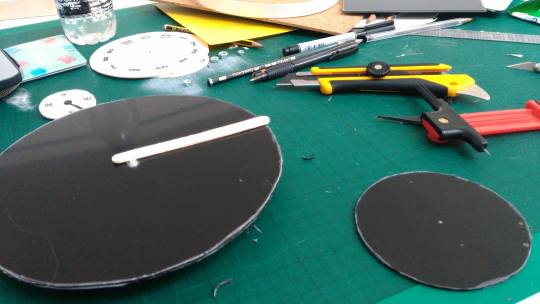

Although the rigidity worked better, the material was just too heavy for the relatively weak mechanism. The motor wasn’t able to turn it, especially when upright. So I went back to mountboard, but this time decided to try laser cutting the shapes to have them fit the rod perfectly and not move around. I digitised my design and put it into a suitable Illustrator file for the machine to be able to process. I was worried that given the thickness of the material and the detail of the shapes I’d drawn, it wouldn’t work. Thankfully, I was wrong.


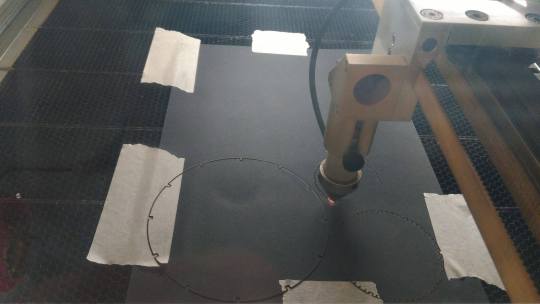

Let’s see how this goes!
2 notes
·
View notes
Text
Unheard Voices 2 - Earle Haas: Poor Traits of A Period
I decided to call the series of films Poor Traits of A Period... again.
The negative and somewhat shocking imagery kind of highlights my messages within the videos.... but... and yes you've guessed it, i’m still not happy with it. The process that I learnt on after effects and Cinema 4D for this project redo was great, and definitely will be beneficial for FMP. However, I still feel as if the message might not be clear enough with the imagery.
Obviously the message works, it’s text on a plain background, and has clear definition of the progress from 10, to 5000, to 250,000,000to 800,000,000,000. The imagery contradicts some of it, and becomes unclear what it i behind the text. The way to solve this would to make the text smaller but I feel as if it would become unclear and not as readable if the text did not take up the majority of the screen when being animated. The footage, unless without text, is lost, and what you can make out of it is still a little strange. Maybe if I had reshot the footage it would have worked out a bit better and made more sense as a campaign.
I am contradicted by Barthe’s point about an image being stronger than a statistic. An image of a dying child is more likely to have an effect on a viewer rather than hearing about a statistic of it. But to me the statistic has to work with the imagery, and perform as a piece together.
Where I went wrong... I always find it difficult to get the right sort of imagery, I really struggle with visualising my ideas, which I didn’t think it did, but from Unheard Voices 1 & 2 and D&AD, it is clear that I have to work on my design skills a bit more. Again like with D&AD, I should look at multiple layouts/outcomes/colour schemes/typefaces. I knew in my head the type of typeface that I needed for my second Unheard Voices, and I knew that I had Oswald already, it did seem appropriate and I for sure did look at using other typefaces but I didn’t follow through with them enough, and put them into Cinema 4D and render them. If i dragged a few more of these alternative or varied designs with me along the process (which of course makes it longer) I would be able to inform my designs a bit more with more experimentation and choice behind it. Like with D&AD, looking at multiple options and choosing the best of all them.
0 notes

